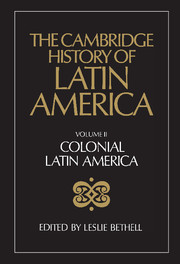Book contents
- Frontmatter
- PART ONE POPULATION
- PART TWO ECONOMIC AND SOCIAL STRUCTURES: SPANISH AMERICA
- 3 The urban development of colonial Spanish America
- 4 Mining in colonial Spanish America
- 5 The formation and economic structure of the hacienda in New Spain
- 6 The rural economy and society of colonial Spanish South America
- 7 Aspects of the internal economy of colonial Spanish America: labour; taxation; distribution and exchange
- 8 Social organization and social change in colonial Spanish America
- 9 Women in Spanish American colonial society
- 10 Africans in Spanish American colonial society
- 11 Indian societies under Spanish rule
- PART THREE ECONOMIC AND SOCIAL STRUCTURES: BRAZIL
- PART FOUR INTELLECTUAL AND CULTURAL LIFE
- Bibliographical essays
- References
6 - The rural economy and society of colonial Spanish South America
from PART TWO - ECONOMIC AND SOCIAL STRUCTURES: SPANISH AMERICA
Published online by Cambridge University Press: 28 March 2008
- Frontmatter
- PART ONE POPULATION
- PART TWO ECONOMIC AND SOCIAL STRUCTURES: SPANISH AMERICA
- 3 The urban development of colonial Spanish America
- 4 Mining in colonial Spanish America
- 5 The formation and economic structure of the hacienda in New Spain
- 6 The rural economy and society of colonial Spanish South America
- 7 Aspects of the internal economy of colonial Spanish America: labour; taxation; distribution and exchange
- 8 Social organization and social change in colonial Spanish America
- 9 Women in Spanish American colonial society
- 10 Africans in Spanish American colonial society
- 11 Indian societies under Spanish rule
- PART THREE ECONOMIC AND SOCIAL STRUCTURES: BRAZIL
- PART FOUR INTELLECTUAL AND CULTURAL LIFE
- Bibliographical essays
- References
Summary
The Andean chain forms the warped backbone of South America. Its central ranges and plateaux constituted the heartland of the Inca empire. To a large extent, they maintained this role within the Spanish possessions throughout the colonial period, thanks to their enormous deposits of silver ore and their plentiful supply of hardy Indian workers. It is true that the northern and southern extensions of the Andes, with the adjacent basins of the Orinoco, the Magdalena and Río de la Plata, grew in economic importance. Yet colonial institutions and society bore above all the imprint of the Castilian conquest of the Inca realm.
Throughout the central Andean highlands (the sierra of present-day Peru, Bolivia, and Ecuador) vegetation, fauna and human conditions are determined primarily by the altitude. The percentage of cultivable land is exceedingly small. Also, the zone of pre-conquest agriculture was confined to between 2,800 and 3,600 metres above the sea. Here, after 1532, wheat and other Old World crops were added to the native maize and tubers. Above this zone, land can only be used for pasture. Here, European cattle and sheep gradually replaced the native llama as the chief resource. The eastern slopes (ceja de montaña) and also the deeper mountain valleys offer areas suitable for growing a wide variety of tropical products such as sugar, cacao, and coffee. The various vertical niches thus provide a surprisingly varied alimentary basis for human civilization, not only on a regional but often on a local level as well.
- Type
- Chapter
- Information
- The Cambridge History of Latin America , pp. 189 - 218Publisher: Cambridge University PressPrint publication year: 1984



